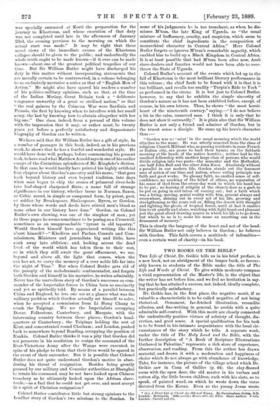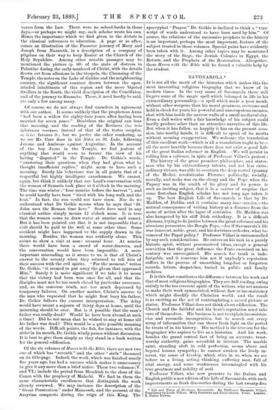TWO BOOKS ON THE BIBLE.* THE Life of Christ, Dr.
Geikie tells us in his brief preface, is a new book, not an abridgment of the longer book, so favour- ably known to students of the Bible under the title of The Life and Words of Christ. To give within moderate compass a vivid representation of the Master's life, is the object that the writer has set before him, and we feel no hesitation in say- ing that he has attained a success, not, indeed, ideally complete, but practically satisfactory.
Dr. Geikie has, in the first place, the negative merit, if so valuable a characteristic is to be called negative, of not being rhetorical. Ornament, far-fetched illustration, recondite allusion, and fine-writing in general, he avoids with a quite admirable self-control. With this merit are closely connected the undoubtedly positive virtues of sobriety of thought, dis- cretion, and good sense. A special qualification for his task is to be found in his intimate acquaintance with the local cir- cumstances of the story which he tells. A separate work, under the title of The Holy Land and the Bible, with the further description of " A Book of Scripture Illustrations Gathered in Palestine," represents a rich store of experience, observation, and reading. From this the author has drawn material, and drawn it with a moderation and happiness of choice which do not always go with abundance of knowledge. Take, for instance, the picture of the village school which Dr. Geikie saw in Cana of Galilee (p. 44), the clay-floored room with the open door, the old master in his turban and cotton slip, the little brown children, each with his slate, so to speak, of painted wood, on which he wrote down the verse dictated from the Koran. Even so the young Jeans wrote
• (L) A Short L(fo of Christ for Old and Young. By Cunningham Geikie, D.D. London : Hatchards 1888.—(2.) Hours with th.t. Bible. Same Author. 6 vols. London : Cassell and Co.
verses from the Law. There were no school-books in those days,—or perhaps we might say, each scholar wrote his own. Hence the importance which we find given to the dictates in the classical references to education. A page or so after, comes an illustration of the Passover journey of Mary and Joseph from Nazareth, in a description of a company of pilgrims on their way to keep Easter at the Church of the Holy Sepulchre. Among other notable passages may be mentioned the picture (p. 69) of the state of distress in Palestine during the early manhood of Christ, with the details drawn out from allusions in the Gospels, the Cleansing of the Temple, the notes on the Lake of Galilee and the neighbouring country, the significant contrast drawn between the open- minded inhabitants of this region and the more bigoted dwellers in the South, the vivid description of the Crucifixion, and of the journey to Emmaus. These, it need hardly be said, are only a few among many.
Of course, we do not always find ourselves in agreement with our author. It seems unlikely that the prophetess Anna 4- had been a widow for eighty-four years, after having been married for seven years." Doubtless the original can bear that meaning, and the reading of the Revisers (is); iris' eviioipeo:eree TiltdepCJY, instead of that of the textus receptus, .i; iriLp) favours it ; but we prefer the other rendering, as we see Mr. Carr does in his Notes on St. Luke, following Jerome and Ambrose against Augustine. In the account of the boy Jesus in the Temple, we feel jealous of anything that would seem to favour the view of his having " disputed " in the Temple. Dr. Geikie's words, "answering their questions when they had given what he thought insufficient replies," might seem to have such a meaning. Surely his behaviour was in all points that of a respectful but highly intelligent catechumen. We cannot, again, but think it unlikely that our Lord's conversation with the woman of Samaria took place at 6 o'clock in the morning. The time was winter (" four months before the harvest "), and he could hardly have been " tired with his long walk and the heat." In fact, the sun could not have risen. Nor do we understand what Dr. Geikie means when he says that St. John uses the Roman time here." Sexta Nora used in any classical author simply means 12 o'clock noon. It is true that the women come to draw water at sunrise and sunset. But it has been pointed out that it is not impossible that a visit should be paid to the well at some other time. Some accident might have happened to the supply drawn in the morning. Besides, the woman was evidently alone. This seems to show a visit at some unusual hour. At sunrise there would have been a crowd of water-drawers, and the conversation would have been impossible. A more important misreading, as it seems to us, is that of Christ's answer to the seventy when they returned to tell him of their success with the evil spirits. " For the moment," writes Dr. Geikie, " it seemed to put away the gloom that oppressed Him." Surely it is more significant if we take it to mean that the victory had been won once for all, and that the disciples must not be too much elated by particular successes, and, as the converse truth, not too much depressed by temporary failures. On another matter, Christ's answer to the man who requested that he might first bury his father, Dr. Geikie follows the current interpretation. The delay would have meant a sojourn of thirty days at home, until the mourning should be over. But is it possible that the man's father was really dead? Would he have been abroad at such a time ? Did he not mean that he wished to stay at home till his father was dead? This would be a quite possible meaning of the words. Difficult points, the fish, for instance, with the stater in its mouth, Dr. Geikie wisely passes without discussion. It is best to give them simply as they stand in a book written for the general edification.
Of the six volumes of Hours with the Bible, there are now two one of which has " seventh " and the other " sixth" thousand on its title-page. Indeed, the work, which was finished nearly five years ago, has had a success which makes it unnecessary to give it any more than a brief notice. These two volumes (V. and VI.) include the period from Hezekiah to the close of the Canon with the prophecy of Malachi. We find in them the same characteristic excellences that distinguish the work already reviewed. We may instance the description of the " Great Persecution" under Manasseh, and the account of the Assyrian conquests during the reign of this King. The apocryphal " Prayer," Dr. Geikie is inclined to think a " tran- script of words understood to have been used by him." Of course, the relations of the successive prophets to the history is an important, perhaps the most important, feature of the subject treated in these volumes. Special pains have evidently been taken with it. Among other topics may be mentioned the story of the Siege, the Jewish Colonies in Egypt, the Return, and the Prophets of the Restoration. Altogether, these Hours with the Bible will be found a valuable help by the student.



































 Previous page
Previous page